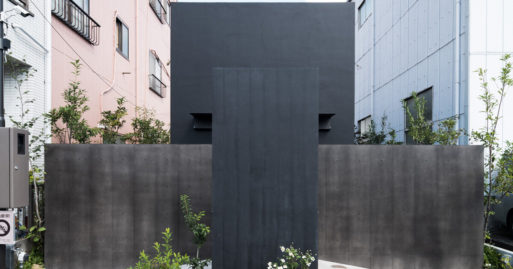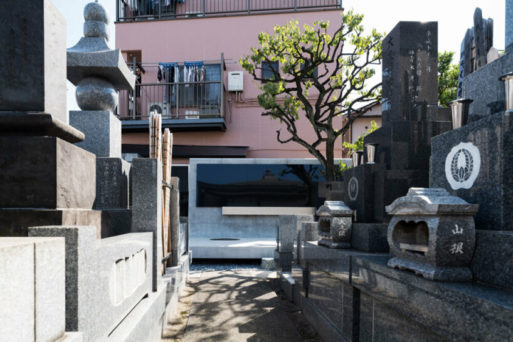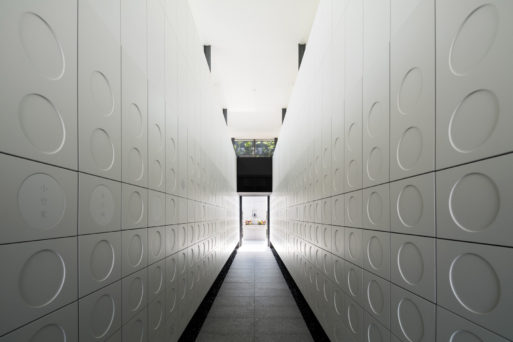
Black regal tones serve as a boundary separating Hyakutukiin in
Shumyo Temple from its city surroundings.
Credit: Love Architecture
The fusion of Japanese burial traditions and modern city space is captured in the creative design behind Hyakutukiin in Shumyo Temple by Love Architecture. The design features a large-scale ossuary; an indoor chamber used to store bones of the dead. The ossuary and tree burial garden are nestled between building exterior walls where a parking lot once operated. Linear black and white tones give a modern feel to Japanese old-world customs.

A blend of tombstones and burial trees create a sacred sanctuary for the deceased at Hyakutukiin in Shumyo Temple.
Credit: Love Architecture
Like many Japanese temples built on large plots of land later swallowed by cities, Shumyo temple subdivided parcels to survive changing times. Love Architecture designed Hyakutukiin as a means to reclaim some of the Temple’s once solemn appearance. The tree burial garden encircles the tunnel-shaped ossuary. Randomly scattered tombstones are highlighted as both landscape and architectural elements. The architects told writers at designboom.com, “Here, the idea was to create a sanctuary through the layout of the graves themselves, taking advantage of the benefits of being assembled.”

White interior walls line the 12-meter long corridor in Hyakutukiin.
Credit: Love Architecture
The tunnel inside the ossuary is a narrow corridor nearly 40 feet long. Granite and gravel shimmer in contrast from dappling sunlight. At the end of the hall sits a Japanese rice paper scroll called a Gohonzon, an important object of worship in many Buddhist temples and altars. Down the center in Japanese Sanskrit reads, “Myoho Renge Kyo.” This symbolizes the mystic law that permeates both life and death.
Although Hyakutukiin is unique in its appearance, ossuaries in big cities are becoming increasingly more common in Japan. According to Toyo University, large ossuaries in metropolitan areas are a new business model for many temples. Baby boomers who once migrated to cities are no longer affiliated with family temples in their native homelands or farming communities. These ossuaries provide them a means for traditional burial in a more convenient location where families can visit to pay respects through ritual customs.
There are also dozens of ossuaries, or bone houses, of varied cultures and beliefs across the globe that display bones of the deceased as a way to honor the dead.

 Hyakutukiin in Shumyo Temple by Love Architecture
Hyakutukiin in Shumyo Temple by Love Architecture


 First the Wealth Gap, Now the U.S. Has a Growing Health Gap
First the Wealth Gap, Now the U.S. Has a Growing Health Gap
 How to Comfort A Dying Loved One
How to Comfort A Dying Loved One
 Our Annual Seven Holiday Gifts for Someone Who Is Grieving, 2024 Edition
Our Annual Seven Holiday Gifts for Someone Who Is Grieving, 2024 Edition














